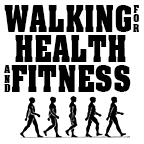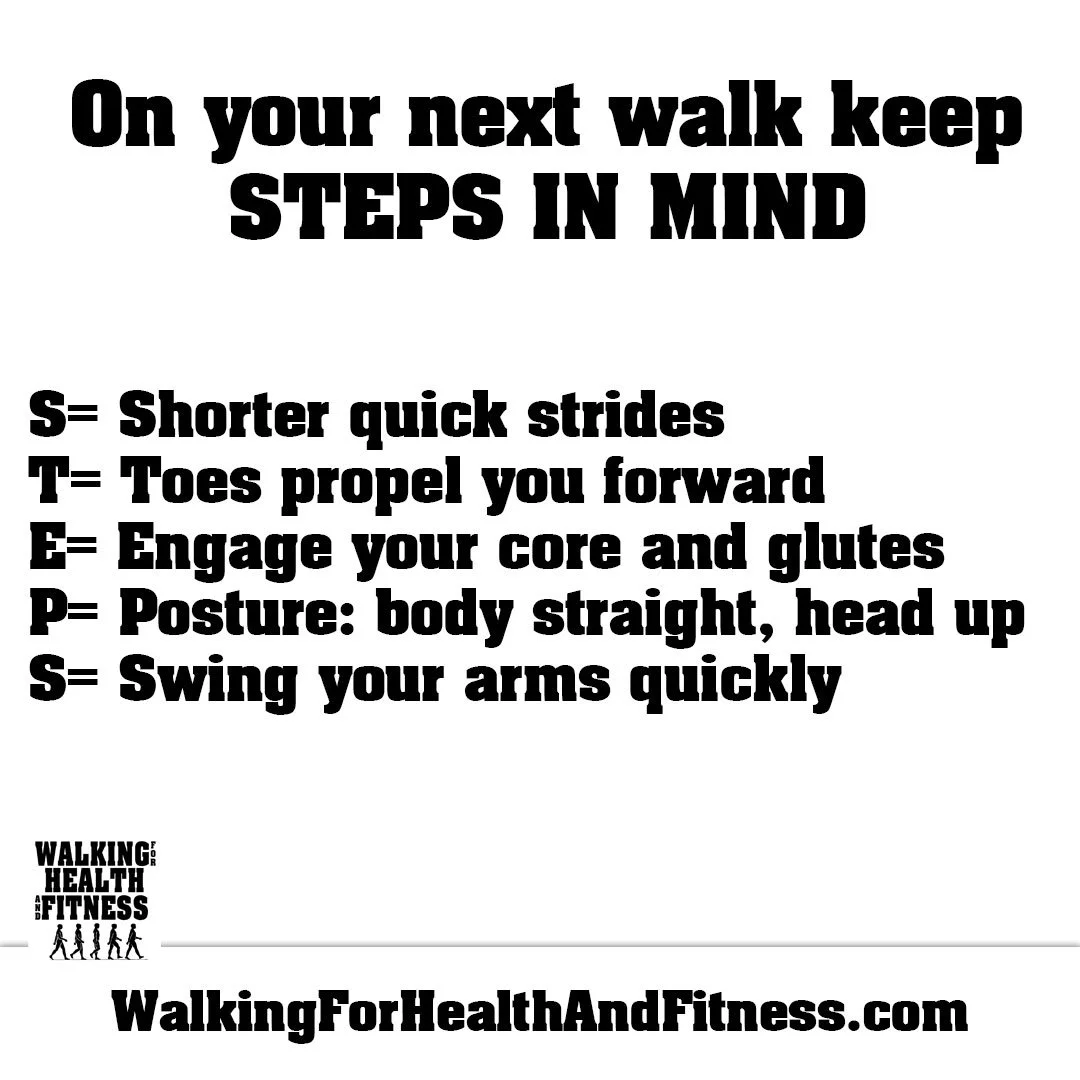Perfect your walking for with my STEPS acronym. The proper walking form is vital to your health and fitness. You'll walk with less effort, breathe more deeply to take more oxygen into your respiratory system and reduce your risk of injury.
Good walking form will also allow you to walk faster. In the Walking for Health and Fitness podcast episode 3, I talked about the benefits of you developing a faster walking speed.
Walking speed is a powerful indicator of vitality: Walking speed studies show that a person's pace, along with their age and gender, can predict their life expectancy just as well as the complex battery of other health indicators, such as blood pressure, body mass index, chronic conditions, and smoking history.
Practice does not make perfect. Only perfect practice makes perfect.
-Vince Lombardi
People in better physical condition tend to walk faster than those who are not.
Slow walking speed has been associated with a higher risk of disability, hospitalization, and mortality. Studies have shown that slower walking speed predicts future health problems and can be a sign of a decline in physical function.
Also, in Episode 3: Walking Speed and Life Expectancy, I discussed the 10-minute time test. A self-diagnostic walking test you should perform at least once a month to determine your overall health and fitness.
After listening to this episode of the Walking for Health and Fitness podcast, go back to episode 3 and review the 10-minute time test and why walking speed is a vital health indicator.
The Importance of Good Walking Form
Having good walking form is essential for a variety of reasons, as it can contribute to your overall health, posture, and well-being.
Let me give you five benefits of maintaining proper walking form:
1. Reduced Risk of Injury: Proper walking form helps distribute each step's impact evenly across your joints and muscles. This can reduce the risk of overuse injuries, such as shin splints, stress fractures, and joint pain. Walking in good form minimizes strain on your body and decreases the likelihood of developing musculoskeletal issues.
2. Improved Posture: Walking with proper form encourages a natural alignment of your spine, shoulders, and hips. This promotes better posture and helps to counteract the adverse effects of prolonged sitting or slouching. Good posture can alleviate back and neck pain and contribute to a more confident and open body stance.
3. Enhanced Muscle Activation: Walking with the correct form engages the muscles in your lower body, including your glutes, quadriceps, hamstrings, and calves. By using these muscles more effectively, you can build strength and endurance, leading to improved overall fitness and better body composition.
4. Efficient Energy Expenditure: Walking with proper form allows you to move more efficiently, which means you use less energy for each step. This efficiency can help you cover longer distances with less fatigue and make your walks more enjoyable. It's especially useful for those who engage in brisk walking or hiking.
5. Cardiovascular Benefits: Walking with good form can contribute to a more effective cardiovascular workout. When your muscles are properly engaged, your heart rate increases and your circulation improves. This can lead to better cardiovascular health, increased lung capacity, and improved oxygen delivery to your body's tissues.
STEPS to Improve Your Walking Form
To improve your walking form, remember the acronym "STEPS"!
This simple mental device to remind you of your walking form will get you moving efficiently with just a little practice.
On your next walk, keep "STEPS" in mind as you take each step.
S = Shorter quicker strides
You may think that a longer stride would help you walk faster, but this is not the case. Increasing your stride puts your legs in an outstretched position which acts as a break. Shorter strides are better.
Turnover rate is the key to faster, efficient walking. The more steps you take per minute, the faster you will walk. Think of a car's piston pumping up and down quickly.
If you walk with music playing, choose songs with different beats per minute, then match your steps to the beat.
Also, try walking to the beat of a metronome. There are free apps available online that you can download and use.
T = Toes propel you forward
Push off of the toes of your back foot, which propels you forward for your next step.
When you first start out with my STEPS analogy, consciously feel yourself pushing off the toes of your back foot.
Once you get the feel of this movement, it will become second nature, and you will naturally propel yourself forward with each step.
E = Engage your core and glutes
As you take a step, squeeze your glutes and engage your core to support your spine.
Strong core muscles; the abdominal muscles, back muscles, and your butt muscles or gluteus maximus are essential to keeping your balance and walking in the correct form.
Doing the bodyweight exercise of planks will help you to strengthen your core muscles quickly.
I'll have more details in a moment.
P = Posture
Keep your body straight and your head up. This expands the chest cavity and increases your oxygen intake by more than 30 percent.
Increasing your oxygen intake is indeed crucial for good health.
Here are three reasons why:
Energy Production: Oxygen is a key component in the process of cellular respiration, where your body breaks down glucose to produce energy. An adequate oxygen supply ensures efficient energy production, which is essential for various bodily functions, from physical activities to mental processes. Insufficient oxygen intake can lead to fatigue, decreased alertness, and impaired cognitive function.
Detoxification: Oxygen is crucial in the body's detoxification processes. It helps convert toxins and waste products into less harmful substances that can be eliminated from the body. Proper oxygenation supports the function of the liver and other detoxifying organs, aiding in the removal of waste and promoting overall health.
Immune System Support: Oxygen is essential for the proper functioning of the immune system. Immune cells use oxygen to carry out various processes, such as attacking and destroying pathogens. Increased oxygen intake can enhance immune responses, helping the body defend against infections and illnesses.
When I'm walking, I visualize my increased oxygen intake as fanning the fire within my body. This internal furnace burns more calories, increases my energy production, burns off toxins, and destroys pathogens. These are all the benefits I just talked about.
Also, when walking with good posture, you will keep your eyes up ahead to help quicken your pace.
Use your peripheral vision to watch where your feet will plant on the ground.
S = Swing your arms quickly
An easy way to quicken your walking speed is to quicken the rate at which your arms swing back and forth.
If you focus on your arms, your legs will naturally follow without the urge to lengthen your stride.
Keep your arms bent slightly and swing them back and forth in a quick and compact motion to increase momentum. Your shoulders should be relaxed and down.
When I was a running coach, I constantly reminded my runners to quicken their arm swing, which led to them taking shorter strides and helping them to increase their leg turnover rate.
During each walk, keep STEPS in mind.
S-shorter quicker strides
T-toes propel you forward
E-Engage your core and glutes
P – Poster; head up to expand your chest and enjoy the benefits of increased oxygen intake.
S – Swing your arms quickly to get the benefits of a faster walking speed.
Pick a point in the distance and consciously apply the STEPS to reach the point. Keep your focus on each of the five aspects of STEPS. Eventually, as your body adjusts to the proper walking form and quicker pace, you will naturally move faster and with more "pep in your step"!
use the correct form to "Step up" Your Average Walking Speed
Why having correct walking form is crucial. It's simple; it's the Cost of Various Health Issues:
A study published in the Journal of the American Heart Association and a study published in The Lancet concluded a person that exercises five times per week paid $2,500 less in annual health care expenses related to heart disease than someone who did not walk or otherwise move for 30 minutes per day five times per week!
The cost of most preventable diseases is staggering.
Doctor's visits, prescriptions, lost time at work, and the lost quality of life due to preventable illness all add up to a significant sum of time and money.
Look at your time and effort spent walking as an investment in yourself. What could be better than that! Your health, happiness, and life depend on it!
Fitness Walking and Bodyweight Exercises
I'm so pleased to announce that My Fitness Walking Exercise Program is now hosted on the Teachable Creators Platform!
What does this mean for you?
Benefits of Hosting this program on Teachable:
• Personalized Unique Login
• Lifetime access to the program
• Safe and secure payment system
• Risk-Free 30-Day Money-Back Guarantee
Performing planks are one part of the Fitness Walking Exercise program.
As I talked about in the P for posture in my STEPS acronym, doing planks will allow you to build stronger core muscles that help with proper posture, leading to a faster walking speed which leads to better health and fitness, which leads to less money spent on health care.
Start getting the best shape of your life today with this 32-minute guided walking and bodyweight exercise program. Walking plus four bodyweight exercises plus 32 minutes equals incredible health and fitness.
You'll see that this program is right for you and comes with over $100 in bonus content.
You have nothing to lose and everything to gain.
Walk on,
Frank S. Ring
Author: Walking for Health and Fitness, Fitness Walking and Bodyweight Exercises, Walking Inspiration, and Walking Logbook Journal.









